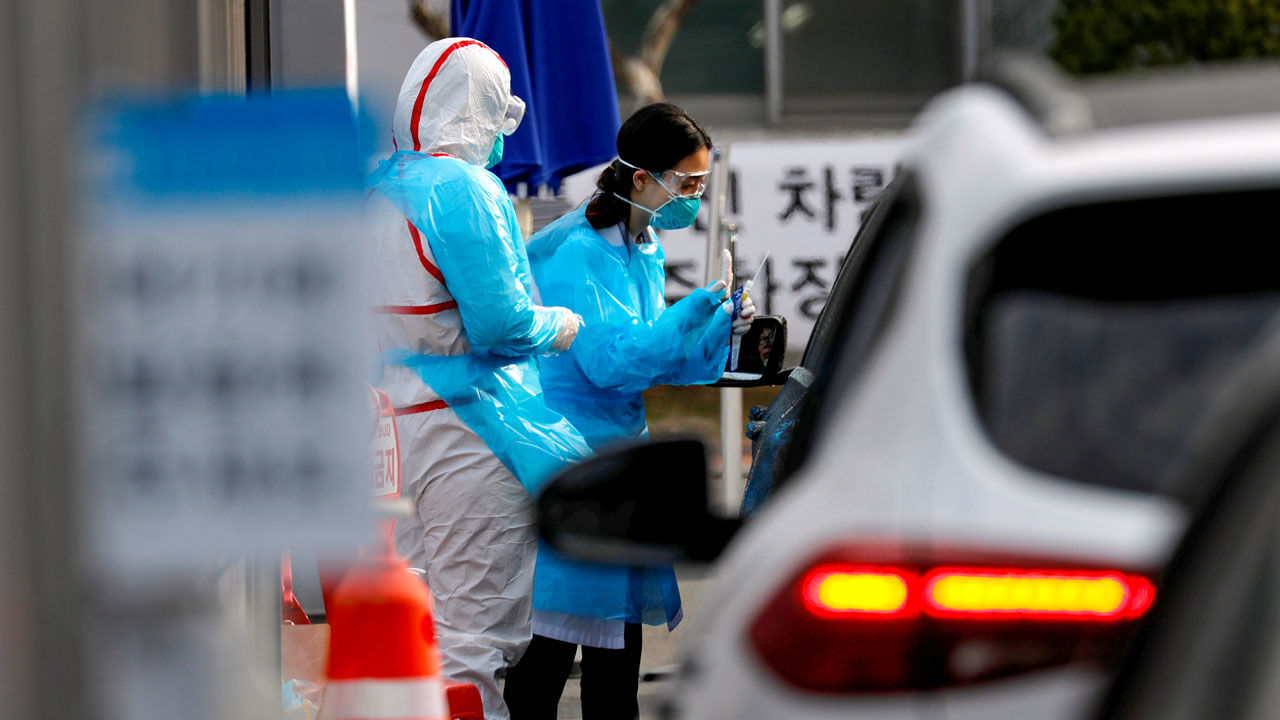Virus testing has been carried out on a large scale and in an orderly manner. South Korea is among the global leaders in providing COVID-19 tests, and so far the number of testing has reached more than 300,000. To prevent people from gathering in hospitals for testing, the South Korean government has set up 600 independent testing centers, which on the one hand screen patients as many and as quickly as possible, and on the other hand reduce face-to-face contact to ensure the safety of medical staff. In addition, South Koreans can get tested at 50 drive-through stations without leaving their cars, or at enclosed walk-in testing stations resembling the phone booth. The testing process takes only 10 minutes, and the result can be back within hours.
A medical officer prepares to take samples from a visitor at a drive-through testing center at Yeungnam University Medical Center.
(Credit: Reuters/KIM KYUNG-HOON)
Making full use of information technology to achieve contact tracing, isolation and surveillance. Health officials use security cameras, credit card records, and even GPS data from cars and mobile phones to track patients’ movements. People will be sent an emergency alert whenever new cases are found in their communities. Those who may have encountered a patient will be urged to report to the testing centers, thus enabling contact tracing. Those who are asked to perform self-isolation must download an APP, and if they venture out of quarantine, the APP will alert officials, and violators can be fined up to $2,500. For the treatment stage, South Korea has formulated a graded policy which divides patients into four levels: light, medium, severe and most severe, so as to keep hospitals clear for the most serious patients.
Valuable public support. Television broadcasts, subway station announcements and smartphone alerts constantly prompt people to wear masks, instruct them to keep distance from others, and report the daily infection data. The infusion of a large amount of information has led to a common sense of purpose among South Koreans similar to that during wartime. Such public trust has brought about a high level of civic awareness and voluntary cooperation that strengthens the efforts in fighting the pandemic.
Well-established legal protection. After the MERS outbreak in 2015, South Korea promptly revised the Infectious Disease Control and Prevention Act, stipulating that during an outbreak, government departments could obtain personal data without authorization and notify the community. On March 26, 2020, the South Korean parliament adopted amendments to the Infectious Disease Control and Prevention Act, the Quarantine Act, and the Medical Services Act, further clarifying the graded prevention and control measures of infectious diseases, and the quarantine rules for foreigners entering the country, and established new infection-monitoring mechanisms for patients, family members and medical staff in medical institutions. The well-established legal protection system not only strengthens the ability to deal with infectious diseases at the national level, but also greatly alleviates public concern about the COVID-19.
Thanks to the above-mentioned effective measures, South Korea has achieved the goal of effectively controlling the outbreak with no city under lockdown, no work being stopped, and ordinary citizens still living as normal.
Workers from a disinfection service company sanitize a branch of the Shincheonji Church of Jesus the Temple of the Tabernacle of the Testimony where a woman known as "Patient 31" attended a service in Daegu.
(Credit: Reuters)
II. Key words for the South Korean economy under the pandemic
The pandemic, due to the international spread of the virus and the economic development in South Korea, means a “bitter winter” for the South Korean economy.
The first key word is contraction. According to the latest data from Reuters, production in South Korea’s factories in February shrank at the fastest pace for the past 11 years, providing the latest proof that the pandemic is having a serious impact on the economy. In seasonally-adjusted terms, industrial production declined 3.8 percent in February from the previous month, sharper than the 1.8 percent decline forecast by Reuters, and the biggest decline since the 10.5 percent drop in December 2008. The situation is expected to be exacerbated by the significant increase in global infection cases during March.
The second key word is shutdown. As the pandemic has raged around the world, and more and more countries have imposed restrictions or halted production activities, South Korean companies have had to suspend overseas production lines. The shutdown in the global supply chain has hit South Korea’s automotive, electronics, steel and other industries hard. Since April, Hyundai Motor and Kia Motor have had to shut down almost all the oversea assembly plants, while in the electronics industry, one-quarter of the 37 production bases of Samsung Electronics at home and abroad have been suspended.
The third key word is nadir. According to the latest (April) traffic data from the Korea Civil Aviation Association, due to the pandemic, passenger numbers on domestic and foreign routes were 10.62 million in January but halved to 5.5 million in February and further declined by 68.3 percent on a month-on-month basis to 1.74 million in March, hitting the lowest level since 1997 when data first became available. From the fact that nine airlines have flown fewer than 2 million passengers in total, it can be seen that the aviation industry is facing the greatest challenge in its history.
The fourth key word is sluggish consumption. As of February, South Korea’s outbound shipments have fallen for 15 consecutive months, while its domestic consumption also has seen a decline. Because of the difficulties in importing food ingredients from China, prices have soared. On top of that, people have refrained from eating out, making it difficult for small and medium-sized catering companies to survive. As things stand, the pandemic has swept through almost all industries. Judging from the current situation, South Korea’s business environment is deteriorating, and more importantly, the crux of the problem is that it is not clear how long it will take for the outbreak to subside in South Korea and around the world.
The fifth key word is subsidies. To minimize the impact of the pandemic on the economy, the South Korean government announced a special economic relief package on February 28. The measures, aimed at overcoming the economic difficulties caused by the pandemic, offer financial support, tax benefits and regulatory innovation, totaling more than $16 billion. The support measures include financial subsidies, tax reductions, low-interest loans to small businesses, and an increase in funds to state-owned enterprises, with the focus on financial subsidies. In terms of enterprise subsidies, the emergency funds for small and medium-sized enterprises hit by the pandemic will be increased to $570 million, while the insurance coverage of accounts receivable held by such enterprises will be increased to $1.8 billion. For businesses with annual sales of below $50,000, value-added tax will be cut until the end of next year. This measure will cause government tax revenue to fall by $720 million over the next two years. To encourage spending, the tax on car purchases will be reduced by 70 percent from March to June; tax deductions on card spending will be significantly adjusted from 30 to 80 percent for credit and debit cards over the same period; and buyers of household appliances will receive a refund of 10 percent. The government will issue “regional gift vouchers” worth $5 billion and provide $2.5 billion in cash vouchers that can be used at traditional markets. To sustain the livelihoods of people, subsidies will be granted to parents who have been caring for children at home because of the closure of daycare centers. Landlords who temporarily lower rents for small and medium-sized businesses affected by the virus outbreak, will be given a tax deduction of 50 percent of the rent reductions they give their tenants.

(Credit: The Economist)
—————————————————————
ON TIMES WE FOCUS.
Should you have any questions, please contact us at public@taiheglobal.org


